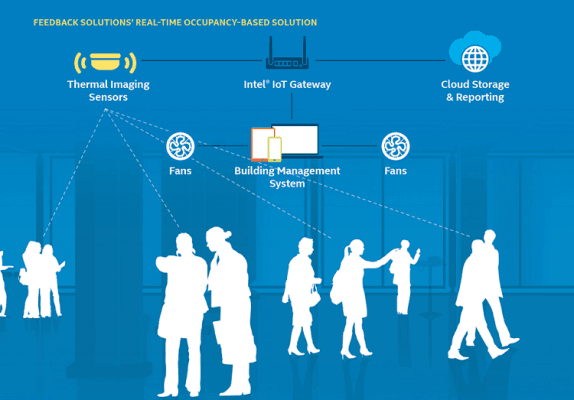People Counting = Energy Savings

Saving energy in high-occupancy buildings often boils down to optimization of HVAC and lighting systems. This precision can be achieved with smart building applications such as space optimization and security automation using technologies that can recognize how many people are in a facility, where, and when.
These use cases can benefit from the ability to count individuals as they enter, exit, and move around building spaces.
High-volume, variable-occupancy facilities such as universities, hotels, airports, convention centers, and more have the most to gain from people counting. But historically, the cost of deploying such solutions has offset any potential savings.
In addition to their high cost, occupancy-sensing solutions like infrared beams or proximity sensors are neither deterministic nor accurate enough to power down smart building systems the moment no one (or anyone) is present. Cameras are expensive, obtrusive, and may require infrastructure like network video recorders that are not directly compatible with building automation system (BAS) servers.
These options inevitably need ongoing management and maintenance that can be pricey and time-consuming. And particularly in a climate of ongoing personal and data privacy issues, video cameras and cell phone tracking present concerns.
Sensor Innovations for Smart Occupancy
Innovative solutions are coming to market that transcend the challenges mentioned above. For instance, advanced thermal imaging counters track the heat signature emitted from each individual. These lens-less sensors are mounted above entryways, and can accurately track how many individuals come in and out, bidirectionally and in real time. 3D or stereoscopic sensors are another highly effective alternative—and do not present privacy concerns.
These sensors don’t record any personally identifiable information and there are no pictographic images, helping ease the privacy concerns that many organizations face. As shown inthe Irisys People Counting Dual View video below (Video 1), thermal imaging abstracts away all of an individual’s unique identifiers.
Furthermore, advanced sensors are easy to deploy, highly accurate, and extremely reliable. For instance, Irisys thermal imaging counters have a mean time between failure (MTBF) of more than 25 years, minimizing the need for sensor recalibration or reconfiguration. Plus, they provide a 60-degree field of view with a range of 10 feet.
But for smart building operators, such sensors are only one part of a much larger, sophisticated occupancy-sensing solution.
Smarter People Counting with AI
The Advanced Occupancy Counters System from Feedback Solutions produces real-time occupant data that allows smart building operators to adjust automation systems. This data, delivered over BACnet IP, enables organizations to automatically reduce energy use and maintain indoor air quality.
To optimize the sensors for use in smart building occupancy management, the company has developed a series of intelligent software algorithms that interpret sensor data occupancy in a given area. These algorithms are deployed on an Intel® IoT Gateway.
The system architecture, displayed in Figure 1, shows how the sensors facilitate energy savings for variable occupancy structures. Each IoT gateway acts as a controller for up to 20 thermal-imaging sensor nodes, all of which are assigned an IP address. But each of those sensors can be relegated as a master sensor that controls two slave nodes, equaling a practical support value of 60 nodes per gateway controller.

The small-footprint software algorithms are capable of running on Intel® Celeron®, Intel Atom®, or higher gateway controllers. Once processed, the IoT Gateway passes this output along to BAS servers over BACnet/IP.
Once the BAS server receives this input, it can communicate with various building subsystems such as HVAC—that consume significant amounts of energy. From there, a sequence of operations can be established—such as decreasing the fan speed of a ventilation unit or turning off the lights in one section of a building. This enables saving energy and costs, while complying with ASHRAE (American Society of Heating, Refrigerating and Air-Conditioning Engineers) standards.
The Feedback Solutions occupancy sensors allow facility managers to define intervals of when data is sent from controllers to BAS servers. Historical occupancy trends data can then be stored on a BAS server hard drive or secure cloud environment so that smart building managers can optimize their facilities over time.
Real-Time Occupancy Data in Action
The University of Toronto had several structures on-campus with HVAC systems that heated and cooled lecture halls, classrooms, offices, and libraries based on maximum capacity, not real-time occupancy. As a result, fans, ventilation systems, and other BAS subsystems were being overused, leading the educational institution to investigate occupancy counters.
After integrating Feedback Solutions’ occupant data with its BAS servers, real-time occupancy values were used to reduce ventilation fan speeds to 40 percent of full operating speed. And every 20 percent reduction in fan speed reduces power consumption by approximately 50 percent, yielding large energy and cost savings.
Over a two-year period, the university was able to save C$1.5 million thanks to the reduction in energy use.
In another example, the University of Alberta needed to better utilize classroom space. In this case, Feedback Solutions’ occupancy sensors helped it compare facility occupancy data, consolidate classrooms to a few buildings, and close others while not in use. The occupancy data also allowed the university to generate usage efficiency metrics for each classroom on an hourly, daily, and weekly basis.
Both universities were concerned with privacy legislation and compliance when evaluating people-counting options. Due to the inherent data anonymization of thermal imaging occupancy sensors and/or stereoscopic sensors, these fears were alleviated. But enterprise-grade security features such as hardware-based crypto acceleration, trusted execution environments, and end-to end network encryption integrated in Intel IoT Gateway platforms helped put these fears to rest.
The Possibilities for Smart Buildings
With the use of advanced sensors, intelligent, private, and secure people counting and monitoring is no longer a thing of the future.
“Real-time occupancy data for ventilation control applications yield benefits across an organization,” said Chandan Chowdhury, CEO of Feedback Solutions. “For example, at a university, there’s an energy and environment group, a sustainability group, and other departments that focus on space utilization planning and operations. They all benefit from the data.”
Chowdhury explained that “each department can get all that data, and start seeing an immediate ROI, and then the savings and data insights simply continue.”
Other ways that Feedback Solutions is looking to advance its BAS technology are through the ability to calculate dwell time, heat mapping, differentiating between adults and children, and so on. But while thermal-imaging and stereoscopic sensors are the front line, none of these applications would be effective, or perhaps even possible, without intelligent software algorithms and a secure, scalable controller.